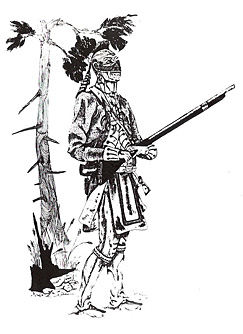colonial period
Conflict and Cooperation among the First Peoples and European Settlers
William Pynchon arrived in the Connecticut River Valley in 1635 and began negotiations with local sachems (hereditary chiefs). In 1636, Pynchon returned with a group of settlers and purchased 150 acres from the Agawam people to build a small settlement and pasture livestock. The agreement allowed Pynchon and his group access to the river for trade and fishing, while the native people reserved for themselves the rights to hunt, fish and gather nuts and berries on the premises, and to keep the cultivated fields where they raised tobacco, corn, beans and pumpkins. West beyond the valley the Agawam held a large domain, as yet undisturbed by whites, to which they could retire.
Pynchon originally named the settlement Agawam Plantation after the local indigenous people, and the Europeans and the First Peoples lived adjacent to each other well into the seventeenth century. Local tribes traded corn, squash and furs with the Europeans in exchange for metal tools, blankets, cloth, glass beads, yarn, ribbon, and jewelry. The local currency of exchange was the natives' shell-bead wampum, which the Europeans adopted and then began to produce for themselves. The First Peoples generally found the Europeans' metal tools superior to their own stone tools, but not all new implements were adopted wholeheartedly. Copper kettles were cut up to make disc and cone-shaped adornments, and muskets were initially perceived as inferior to the native alternatives.
In the early years, the interaction between the indigenous people and the European settlers benefited both sides. The prosperity of the settlement that eventually became Springfield relied upon pelts acquired from the native people, and the settlers drew their food supply from animals and crops familiar to the Agawam. From the white settlers the Agawam acquired tools and materials, and protection against their traditional enemies, the Mohawks.
By 1650, the size of both the colonial and native populations had grown significantly. Over-hunting had depleted the number of beavers and otters in the region, and intertribal warfare began to affect the economy and daily life in the Connecticut River Valley. 1 Pynchon and other colonial leaders began to exploit tribal trade debts to bargain for more land while expanding the influence of English government and religion over the indigenous population. 2 The growing English influence and continuing intertribal tensions finally culminated in King Philip's War (1675-1677), during which native warriors attacked travelers and colonial settlements across southern New England. Native groups attacked Springfield, burning the settlement to the ground. In retaliation the English massacred nearly 400 native refugees camped at Turner's Falls. By the war's end nearly 8,000 Native Americans had been killed, enslaved, or displaced. Sporadic violent conflict between the First Peoples and Europeans settlers continued into the late eighteenth century.After King Philip's War, the Europeans established a dominant presence in New England. The legacy of the First Peoples of the Connecticut River Valley is still apparent, however. Tobacco and corn remain major crops in the area, and everything from banks and parks to residential streets and area schools are named for the valleys earliest inhabitants.
1 Peter A. Thomas, "Into the Maelstrom of Change," from K.W. Buckley (ed), In A Place Called Paradise: Culture and Community in Northampton, Massachusetts, 1654-2004 (Amherst, MA: University of Massachusetts Press, 2004), p. 15.
2 Margaret M. Bruchac, "Native Presence in Nonotuck and Northampton," from K.W. Buckley (ed), In A Place
